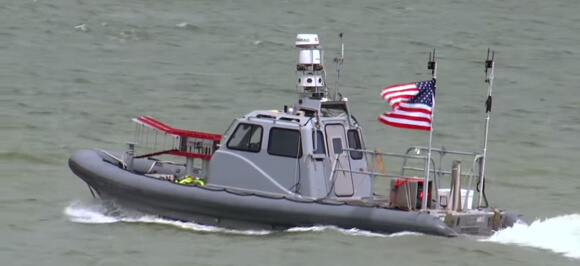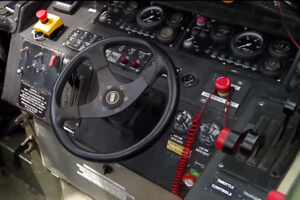Navy’s Boat Drones Pack Hunt Like Wolves on Water

Share
The US military is building a droid (er, drone) army. You’ve likely heard of flying drones—but the robot arms race won’t end there. The Navy recently demonstrated a pack of autonomous boats performing defensive and offensive swarm tactics.
Why robots? The military hopes to augment its human forces with superhuman robotic abilities, while at the same time putting fewer soldiers in harm’s way. The Navy’s autonomous boat program was motivated, in part, by the 2000 terrorist attack on the USS Cole, in which a boat brimming with explosives rammed the destroyer’s hull.
In the future, armed autonomous boats might approach such threats, take fire without risking human lives, and if necessary, neutralize or destroy the adversary.
The test operations—which took place in August but were only recently revealed by the Office of Naval Research (ONR)—involved up to 13 standard rigid-hulled inflatable boats using automation technology originally developed for NASA’s Mars rovers.
The exercise was split into defensive and offensive systems tests conducted on the James River in Virginia. The fleet of robot boats first acted as escort to a larger ship before spotting a designated “enemy” vessel across the river. Eight of the ships then peeled off the main formation and surrounded the enemy ship.
We’ve long been able to remotely pilot unmanned boats and flying machines, but this latest generation incorporates more autonomy. The Navy’s swarmboats run smart software called Control Architecture for Robotic Agent Command and Sensing (CARACaS). The system handles individual vessels and coordinates the larger group.
The boats use radar to calculate their individual paths through the water, avoiding obstacles and maintaining position relative to the other boats. Meanwhile, each individual shares its radar with the group to construct a picture of the whole.
Perhaps the most uncharacteristic part of the technology, however, is its cost.
The boats themselves are standard issue—instead of cutting-edge, specially tailored marvels that take a decade to develop—and outfitting them with the necessary artificial intelligence and communications equipment costs only $2,000.
Upgrading the current fleet, the Navy says, would cost thousands, not millions. And because the boats are relatively cheap and pilotless, the Navy can overwhelm targets with numbers and liberally employ kamikaze tactics, where some individuals sacrifice themselves to ensure the success of the larger strategy.
Be Part of the Future
Sign up to receive top stories about groundbreaking technologies and visionary thinkers from SingularityHub.


Further, a team instantly and electronically sharing and acting on information from a variety of viewpoints can accomplish things none of its individuals could accomplish acting independently—the whole is greater than the sum of its parts.
Flying drones, while more expensive, are similarly being developed with more autonomy in mind. While early drones were piloted remotely, the Navy’s X-47B can fly itself and even autonomously land on an aircraft carrier. The Navy expects advanced drone fighter jets might also make use of swarm tactics in the air.
Along with autonomous war machines comes the question of ethics: Just how autonomous are we talking here? The Navy says their autonomous boats will be able to locate and engage adversaries—but a human will always pull the trigger.
This is in line with a position the Pentagon outlined in a 2013 policy directive.
In the future, then, perhaps warriors removed from the immediate threat to life and limb will be able to more cooly survey situations. Reducing heightened levels of fear and adrenaline could potentially reduce civilian and “friendly fire” casualties.
Alternatively, distance might make combat too game-like and encourage unethical decisions. And no robot or AI system is perfect, nor is wireless communication completely reliable—especially on the battlefield. Further, military robots won’t be used by the US alone, but other nations with other guidelines too. A broad discussion and agreement on the ethical use of the machines is needed (and indeed, is underway).
In the meantime, expect to see increasingly autonomous robots making their way toward the battlefield. The Navy says their robotic swarmboats could be rolled out in a year for escort missions in dangerous areas. They hope to first improve the boats’ navigation and sensing abilities, but believe they’ll eventually be widely used.
Importantly, those uses won’t be solely military. Pilotless cargo ships, for example, may soon cross the seas with skeleton crews. Driverless trucks will do the same on land. Drones may deliver Amazon goodies the same day or medicine to the rural poor.
Such technology will likely have more peaceful applications than violent ones.
Image Credit: Office of Naval Research/YouTube
Jason is editorial director at SingularityHub. He researched and wrote about finance and economics before moving on to science and technology. He's curious about pretty much everything, but especially loves learning about and sharing big ideas and advances in artificial intelligence, computing, robotics, biotech, neuroscience, and space.
Related Articles

This Light-Powered AI Chip Is 100x Faster Than a Top Nvidia GPU

These Robots Are the Size of Single Cells and Cost Just a Penny Apiece

Hugging Face Says AI Models With Reasoning Use 30x More Energy on Average
What we’re reading



